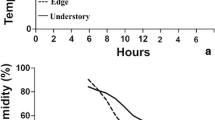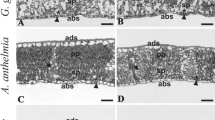Summary
The creosote bush (Larrea tridentata) is a common desert perennial with bifoliate, amphistomatic, divaricate leaves. The leaves can vertically close their folioles and vary their profile with respect to direct solar radiation. Field data from different Mexican deserts showed a significant correlation between foliole aperture and mean foliole inclination: in plants in which folioles were more open, the foliole surfaces were less vertical. In a series of field experiments in the Chihuahuan Desert, foliole aperture varied significantly with the water-status of the plant and the hour of the day. In moist plants, folioles opened in the early morning and closed in the afternoon. Water-stressed plants showed significantly lower foliole apertures. A simulation of the light interception patterns of the plants showed that foliole closure in water-stressed individuals reduces direct radiation interception by around 24%. Most (64%) of the reduction in interception was due to the vertical inclination of the photosynthetic surfaces induced by foliole closure in the water-stressed plants. The rest (36%) of the reduction in interception was due to differential self-shading between foliole pairs, which was higher in the closed folioles of the water-stressed plants, but operated more towards the early hours of the day.
Similar content being viewed by others
References
Ashby E (1932) Transpiratory organs of Larrea tridentata and their ecological significance. Ecology 13:182–188
Barbour MG, Diaz DV, Breidenbach RW (1974) Contributions to the biology of Larrea species. Ecology 55 (6):1199–1215
Batschelet E (1981) Circular Statistics in Biology. Academic Press, London & New York
Ehleringer JR, Werk KS (1986) Modifications of solar-radiation absorption patterns and implications for carbon gain at the leaf level. In: T.J.Givnish (ed) On the economy of plant form and function. Cambridge University Press, Cambridge, pp. 57–82
Ezcurra E, Montaña C, Arizaga S (1991) Architecture, light interception, and distribution of Larrea species in the Monte Desert, Argentina. Ecology 72 (1):23–34
García E, Soto C, Miranda F (1960) Larrea y clima. Anales del Instituto de Biología de la Universidad Nacional Autonoma de México 31:133–171
Gates DM (1980) Biophysical Ecology. Springer, New York. 611 p
Greig-Smith P (1983) Quantitative plant ecology (3rd. edition). Blackwell Scientific Publications, Oxford
Hollander M, Wolfe DA (1973) Nonparametric statistical methods. J. Wiley & Sons, New York
Hunziker JH, Palacios RA, De Valesi AG, Poggio L (1972) Species disjunctions in Larrea: Evidence from morphology, cytogenetics, phenolic compounds, and seed albumins. Ann. Missouri Bot Gard 59:224–233
Hunziker JH, Palacios RA, Poggio L, Naranjo CA, Yang TW (1977) Geographic distribution, morphology, hybridization, cytogenetics and evolution. In: Mabry TJ, Hunziker JH, DiFeo DR (eds) Creosote Bush. Biology and Chemistry of Larrea in New World Deserts. US/IBP Synthesis Series No.6. Dowden, Hutchinson and Ross, Stroudsburg, Pennsylvania, pp 10–47
McCullagh P, Nelder JA (1985) Generalized Linear Models. Chapman and Hall, London, U.K.
Montaña C (ed) (1988) Estudio integrado de los recursos vegetación, suelo y agua en la Reserva de la Biosfera de Mapimí. Publication No. 17, Instituto de Ecología, México.
Monteith JL, Unsworth MH (1990) Principles of Environmental Physics. Edward Arnold, London
Neufeld HS, Meinzer FC, Wisdom CS, Sharifi MR, Rundel PW, Neufeld MS, Goldring Y, Cunningham GL (1988) Canopy architecture of Larrea tridentata (DC.) Cov., a desert shrub: foliage orientation and direct beam radiation interception. Oecologia (Be.) 75:54–60
Nobel PS (1982) Orientation of terminal cladodes of platyopuntias. Bot Gaz 143(2):219–224
Nobel PS (1988) Environmental biology of agaves and cacti. Cambridge University Press, Cambridge. pp, 270
Pyykkö M (1966) The leaf anatomy of East Patagonian xeromorphic plants. Ann Bot Fen 3:453–622
Ragonese AM (1960) Estudio anatómico de las especies argentinas de Larrea (Zygophyllaceae). Revista de Investigaciones Agrícolas 14(4):355–370
Runyon EH (1934) The organization of the creosote bush with respect to drought. Ecology 15:128–138
Sokal RR, Rohlf FJ (1969) Biometry. W.H. Freeman, San Francisco
Yang TW (1970) Major chromosome races of Larrea divaricata in North Am J Ariz Acad Sci 6:41–45
Author information
Authors and Affiliations
Rights and permissions
About this article
Cite this article
Ezcurra, E., Arizaga, S., Valverde, P.L. et al. Foliole movement and canopy architecture of Larrea tridentata (DC.) Cov. in Mexican deserts. Oecologia 92, 83–89 (1992). https://doi.org/10.1007/BF00317266
Received:
Accepted:
Issue Date:
DOI: https://doi.org/10.1007/BF00317266




